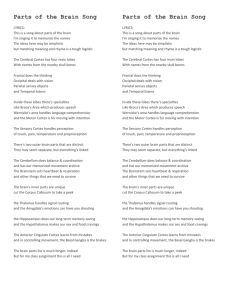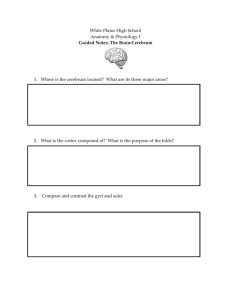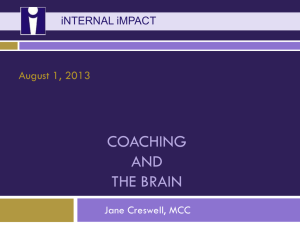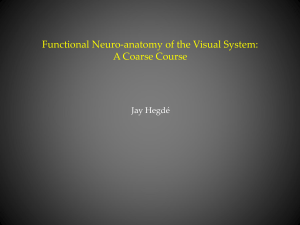Chapter 8: Mechanisms of Perception
advertisement
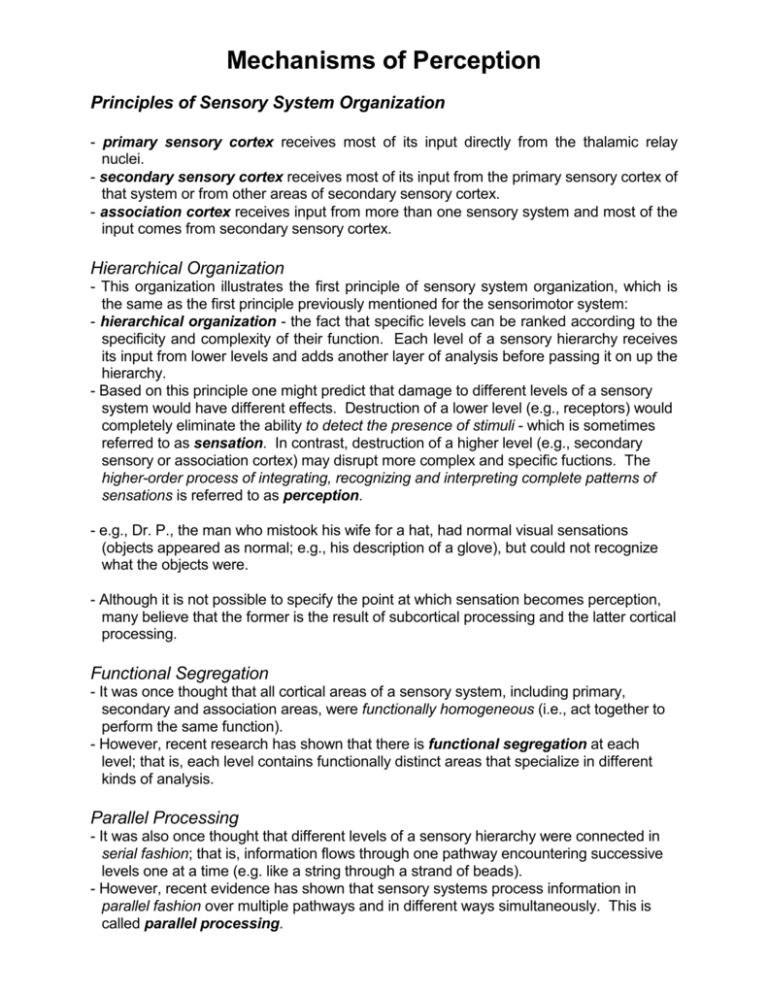
Mechanisms of Perception Principles of Sensory System Organization - primary sensory cortex receives most of its input directly from the thalamic relay nuclei. - secondary sensory cortex receives most of its input from the primary sensory cortex of that system or from other areas of secondary sensory cortex. - association cortex receives input from more than one sensory system and most of the input comes from secondary sensory cortex. Hierarchical Organization - This organization illustrates the first principle of sensory system organization, which is the same as the first principle previously mentioned for the sensorimotor system: - hierarchical organization - the fact that specific levels can be ranked according to the specificity and complexity of their function. Each level of a sensory hierarchy receives its input from lower levels and adds another layer of analysis before passing it on up the hierarchy. - Based on this principle one might predict that damage to different levels of a sensory system would have different effects. Destruction of a lower level (e.g., receptors) would completely eliminate the ability to detect the presence of stimuli - which is sometimes referred to as sensation. In contrast, destruction of a higher level (e.g., secondary sensory or association cortex) may disrupt more complex and specific fuctions. The higher-order process of integrating, recognizing and interpreting complete patterns of sensations is referred to as perception. - e.g., Dr. P., the man who mistook his wife for a hat, had normal visual sensations (objects appeared as normal; e.g., his description of a glove), but could not recognize what the objects were. - Although it is not possible to specify the point at which sensation becomes perception, many believe that the former is the result of subcortical processing and the latter cortical processing. Functional Segregation - It was once thought that all cortical areas of a sensory system, including primary, secondary and association areas, were functionally homogeneous (i.e., act together to perform the same function). - However, recent research has shown that there is functional segregation at each level; that is, each level contains functionally distinct areas that specialize in different kinds of analysis. Parallel Processing - It was also once thought that different levels of a sensory hierarchy were connected in serial fashion; that is, information flows through one pathway encountering successive levels one at a time (e.g. like a string through a strand of beads). - However, recent evidence has shown that sensory systems process information in parallel fashion over multiple pathways and in different ways simultaneously. This is called parallel processing. 2 Current Model of Sensory System Organization - In the 60’s the sensory systems were believed to be hierarchical, functionally homogeneous, and serial. However, four decades of research have established that they are hierarchical, functionally segregated or heterogeneous, and parallel. Note that the difference involves only two attributes: functional segregation and parallel processing. - If the current model, with functional segregation and parallel processing, is correct then how do our brains combine the information processed by multiple pathways to produce integrated perceptions? - One idea is that these pathways might converge at the top of the hierarchy; however there is no area of cortex that receives input from all of the lower levels of a sensory system. - Therefore it is likely that perceptions are a product of the combined activity of many cortical areas within a sensory system. 8.2 Cortical Mechanisms of Vision - The primary visual (or striate) cortex is located in the posterior region of the occipital lobe, with much of it hidden from view in the longitudinal fissure. - The secondary visual cortex is located in two areas: the prestriate cortex - which is a band of tissue in the occipital lobe that surrounds the striate cortex - and the inferotemporal cortex which is in the inferior part of the temporal lobe. - There are several areas of association cortex that receive visual input, but the largest one (discussed in the chapter) is the posterior parietal cortex. - We have just described these cortical visual areas in their proper hierarchical sequence and as a general rule as you move up the hierarchy the neurons have larger receptive fields and the stimuli to which they respond are more specific and complex. Scotomas and Completion - Damage to the primary visual cortex in one hemisphere results in a scotoma (an area of blindness) in the contralateral visual field of both eyes (hemianopsia). - The method used to determine the area of blindness is called perimetry . This test given to patients suspected to have damage in the visual cortex. The patient stares with one eye at a fixation point on a screen while a small dot of light is flashed in various areas. The patient presses a button when the dot is in view. This procedure results in a map of the visual field of each eye. - In patients with damage to the primary visual cortex the center of the field of vision is frequently spared (macular sparing). - We discussed the phenomenon called completion last week (with respect to the blind spot or optic disk) - Scotoma patients frequently report seeing a whole figure even though part of the figure lies within the blind portion of the visual field. For example if a patient with hemianopsia focuses on a persons nose they might see a complete face even though half of it lies within the blind part of the visual field. - Is the completion phenomenon based on some spared or residual visual function? 3 It could be in some cases but if you cover up the half of the face that lies within the scotoma they still see a complete face - suggesting that the visual system is filling in the gap just as it does with our natural blind spot. - Karl Lashley, the esteemed physiological psychologist (who Pinel considered the father of the field in the first edition of his text) frequently experienced a large scotoma during migraine attacks and would cut off the head of the person he was talking to; the wallpaper in the background would fill in the gap of the persons missing head. Blindsight: Seeing without Consciousness - Patients with complete lesions of the primary visual cortex report total blindness yet can perform some visually guided tasts such as grabbing for an object or indicating the direction of an objects movement. This ability to perform some visual tasks without conscious awarness is known as blindsight. - How can patients with damage to the primary visual cortex see features of visual stimuli - primarily their location, orientation, and movement - without being aware of it? - Some subcortical visual signals bypass the primary visual cortex and go to the prestiate cortex and could mediate the spared visual function. - Although in the second edition Pinel discribed one of these pathways that projects from the superior colliculi to the pulvinar nuclei of the thalamus, and from there directly to areas of the secondary visual cortex (collicular-pulvinar pathway); but then Pinel hedged this possibility by saying that it had not held up well against experimental tests. I guess this has resulted in the specifics being removed from the current edition but the idea is still there, so maybe there is some other pathway. - Regardless of the basis of the spared visual abilities the fact that the patients are not consciously aware of visual stimuli suggests that the primary visual cortex is critical for conscious awareness. Perception of Subjective Contours - Perceived visual contours that do not exist are called subjective contours and demonstrate that our visual perceptions are often better than the physical reality of visual input. - (Figure 8a) - You should see a circle in the top illustration and a triagle in the bottom one (especially since I selected a circle and triangle with the computer program and then removed the contour or border). - If you don’t see these shapes than I suggest getting an MRI because you might have damage to your visual cortex. - What areas are important for perceiving subjective contours? Research shows that prestriate neurons and even primary visual cortical neurons respond when subjective contours of the appropriate orientation appear in their receptive field (Figure 8b). Functional Segregation in Visual Cortex: The Dorsal and Ventral Streams* - Secondary and association visual cortex is composed of many different functional areas; in the macaque 24 in secondary visual cortex and and 7 in association cortex with over 300 interconnecting pathways. - Ungerleider and Mishkin (1982) were the first to point out that many of the parallel visual pathways can be divided into two general streams: 4 - The dorsal stream flows from the primary visual cortex to the dorsal prestriate and then to the posterior parietal cortex. - The ventral stream flows from the primary visual cortex to the ventral prestriate and then to the inferotemporal cortex. - Ungerleider and Mishkin proposed that the dorsal stream is involved in the perception of “where” objects are and the ventral stream is involved in the perception of “what” objects are. - Some of the evidence supporting this “where” versus “what” theory comes from patients with damage to either posterior parietal cortex (dorsal stream) or the inferotemporal cortex. Patients with damage to the posterior parietal cortex have difficulty reaching accurately for objects that they have no difficulty identifying and patients with damage to the inferotemporal cortex have an opposite pattern - impaired object identification and spared reaching. - Goodale and Milner have proposed an alternative theory: instead of “where vs what” they propose that the distinction should be “how vs what”. They stress that the difference isn’t in the kind of information the two streams deal with but rather the use to which the information is put. The dorsal stream directs behavioral interactions with objects while the ventral stream mediates the conscious perception of objects - The evidence for Goodale and Milner’s theory is that patients with dorsal damage who have difficulty picking up objects can often describe the size, location, shape, and movement of objects in great detail; whereas patients with ventral damage have difficulty describing the size, shape, location and movement of objects but show that these attributes have been perceived by their precision of reaching and grasping behavior. - Case D.F., who had damage to the prestriate cortex (presumable the ventral “what” stream of both theories) couldn’t describe the details of the object very well but did demonstrate that size and shape information was perceived by changing her reaching and grasping movements in accordance with the dimensions of the object. How does this case contradict the “where vs what” theory of Ungerleider and Mishkin? Visual Agnosia - Agnosia is a failure of recognition that is not attributable to sensory, verbal, or intellectual impairment. It is usually specific to a particular sensory system. - Visual agnosia is classified according to the category of visual material; prosopagnosia (faces), movement agnosia, object agnosia,or color agnosia. - Some believe that prosopagnosia results from damage to an area of visual cortex that specializes in the recognition of faces. The supportive evidence is that they can recognize other test objects (e.g. a chair, pencil or door). - However, this logic is flawed. Why? Prosopagnosics can recognize that a face is a face, so their is no reason why they should not be able to recognize a chair as a chair or a pencil as a pencil etc. - They have a specific deficit in recognizing or distinguishing among similar members of a particular class of visual stimuli (e.g. the prosopagnosic farmer could no longer identify individual cows; and the prosopagnosic bird watcher could no longer identify particular types of birds). - Histological findings suggest that prosopagnosics have damage to the inferior prestriate cortex and the adjoining portions of the inferotemporal cortex. Consistent with this 5 evidence is the finding that individual neurons in the inferotemporal cortex respond selectively to faces.




